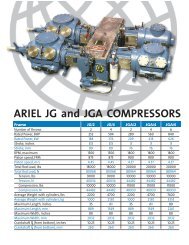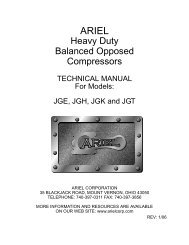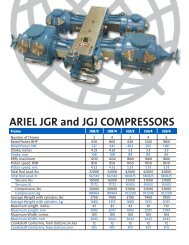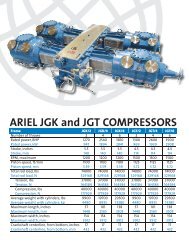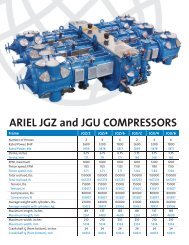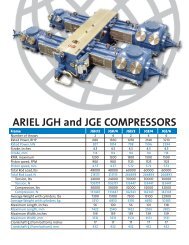Heavy Duty Balanced Opposed Compressors
Heavy Duty Balanced Opposed Compressors
Heavy Duty Balanced Opposed Compressors
Create successful ePaper yourself
Turn your PDF publications into a flip-book with our unique Google optimized e-Paper software.
FOR MODELS: JG AND JGA SECTION 4 - LUBRICATION AND VENTING<br />
Force Feed Lubrication System - Description<br />
The force feed lubrication system provides oil to the compressor cylinders and the piston rod<br />
packings. Refer to Figure 4-8: on page 4-18.<br />
All cylinders have both top and bottom lubrication injection points available as an original<br />
order option, except for the 1-3/4JG-HE and 13-1/2JG class cylinders where “both top and<br />
bottom” is provided.<br />
Oil is supplied to the 150 micron sintered bronze filter on the suction side of the force feed<br />
lubricator pump directly from the pressure side of the frame lube oil system, or from an overhead<br />
tank (see Figure 4-9: on page 4-20). The filter, that prevents large particles from entering<br />
the pump, is mounted on the lubricator box using a bracket. The filter inlet is on the side<br />
of the filter housing and is provided with a 1/4 inch tube fitting connection.<br />
The lubricator box has its own oil reservoir to lubricate the worm gear and cam. The reservoir<br />
is self-contained and is not directly fed by the lube oil system. Lubricator pump overflow<br />
spills into the lubricator box reservoir. A drain prevents the reservoir from overflowing. A<br />
sight glass on the lubricator will show the oil level in the lubicator reservoir. Refer to Figure<br />
5-10: on page 5-17.<br />
There are 1/4 inch tube fitting connections in the discharge line near the force feed lubricator<br />
pump through which the force feed lubricator system may be primed. See “Priming/Purging<br />
the Force Feed System” on page 3-9.<br />
Next in the discharge line is a blow-out disc. If there is a blockage in the system, the pressure<br />
build-up will fracture the disc. Venting the system through the blow-out disc causes the<br />
no-flow shutdown switch to close.<br />
The oil then travels to the distribution block. It is here that the lubricating oil is apportioned to<br />
provide the exact amounts to the cylinders and packings. The pistons in the intermediate<br />
sections of the distribution block move back and forth in a continuous cycle, forcing lubricant<br />
successively through the several outlets as long as lubricant is supplied under pressure at<br />
the inlet. Each outlet has a check valve to prevent oil from backing up in the block. An indicator<br />
on the block shows the rate at which the block is cycling. A pressure gauge is provided at<br />
each distribution block inlet to show system pressure.<br />
From the distribution block, oil travels to the cylinders and packings.<br />
Check valves are located at each injection point where 1 inch minimum (25mm) of head is<br />
provided to ensure reliable check valve operation and to lengthen check valve life. At lube<br />
points where 1 inch of head is not feasible, an oil trap fitting is installed (refer to Figure 4-7:<br />
on page 4-18).<br />
Some of the oil to the packing travels through to the cylinders, but the bulk of it is drained out<br />
through the pressure vent/drain fitting on the bottom of the crosshead guide and through the<br />
atmospheric drain also in the bottom of the guide.<br />
An oil level control valve, supplied by the packager and mounted on the skid, maintains<br />
proper level in the crankcase sump to replace oil used in cylinder lubrication.<br />
11/01 PAGE 4 - 11





